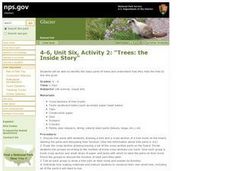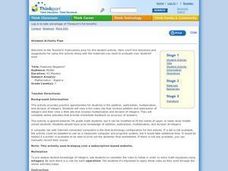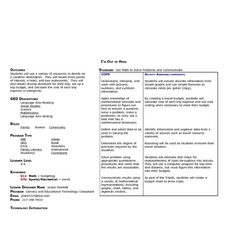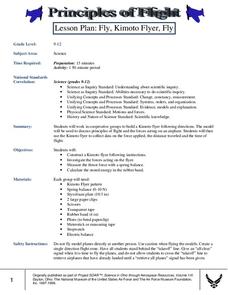Curated OER
Snakes
Students follow directions to make a snake out of patterns. They research a specific snake and present it to the class in a group. They listen to a presentation about the King Cobra snake prepared by the teacher.
Curated OER
In and Out Function
Third graders examine how to solve in and out function problems, or mystery numbers. They analyze a variety of mystery number problems together and extend the patterns. Students then independently complete a Mystery Number activity...
Curated OER
Exploring Roman Numerals
Students construct their own knowledge of Roman numerals by using a Roman numeral calculator on their handhelds. They review the values of Roman numerals. Students explain patterns in Roman numerals, compare and contrast Roman numerals...
Curated OER
Show Me!
Students analyze and interpret graphs. In this graphing lesson, students view a video and construct their own graphs (line, circle, bar) from given sets of data.
Curated OER
Fractions: Parts of a Set
Students identify, model, and label simple fractions. They describe and define them as equal parts of a whole, a region and a set. Students use words to describe fractions. They use manipulatives to explore the many different fractions.
Curated OER
Apples, Apples, Apples
Learners complete activities using apples that help improve their science, math, and reading skills. In this apple lesson, students read the book Apples, Apples Apples and visit an orchard or farmer's market to buy a variety of apples....
Curated OER
Trees: The Inside Story
Students explore trees. In this math lesson, students identify the basic parts of trees. Students create a model of a tree and label the parts.
Curated OER
Altimetry
Fifth graders accurately measure the distance to eight points on an uneven surface by conducting a simulation of sattelite altimetry. They create a two-dimensional model of the simulated ocean surface by graphing data from the Radar Run...
Baylor College
About Air
Give your class a colorful and tasty representation of the components of the mixture that we call air. Pop a few batches of popcorn in four different colors, one to represent each gas: nitrogen, oxygen, argon, and carbon dioxide. The...
Albert Shanker Institute
Economic Causes of the March on Washington
Money can't buy happiness, but it can put food on the table and pay the bills. The first of a five-lesson plan unit teaches pupils about the unemployment rate in 1963 and its relationship with the March on Washington. They learn how to...
Teach Engineering
Ampere's Law
Help your class find the the magnetic field of a toroid, a solenoid bent into a circle with an activity that allows the class to see how a loop of wire carrying an electrical charge behaves much like a magnet. The resource provides...
Teach Engineering
Magnetic Fields
Introduce your class to magnetic fields with an activity that demonstrates that a compass is affected by the magnetic field of the earth, unless a closer, stronger magnetic field is present. Pupils can use this fact in the...
Baylor College
Digestion
Digestion is an amazing and complicated process that provides humans with the energy they need to survive. Lesson six in this series on the science of food uses sliced turkey and a meat tenderizer to demonstrate how enzymes help break...
Curated OER
Scatter Cat!
First graders read the story Hairy MacLary, Scatter Cat by Lynley Dodd, to provide a context in which to use the language of movement and position and to provide opportunities to move themselves as they act out parts of the story.
Curated OER
Spinner Experiment
Students collect and analyze data, then draw conclusions from the data and apply basic concepts of probability.
Curated OER
Positively Negative?
Middle schoolers practice the addition, subtraction, multiplication, and division of integers. They view a video clip on addition and subtraction of integers. Students observe a Web site that reviews multiplication and division of...
Curated OER
Subtraction of Mixed Numbers
Students subtract mixed numbers that require regrouping and have a difference less than fifty.
Curated OER
What Is It?
Students explore the likelihood of events. In this logical thinking lesson, 3rd graders are given several scenarios and determine whether the possibility of the described event actually happening is likely, unlikely, or...
Curated OER
How Many More on a Graph?
First graders examine data on a graph and determine which variable on the graph has more. They draw pictures of their family members and determine which families have more members than other families. Using squares of paper to depict...
Curated OER
Types of Things
Students explore the differences between man-made and natural objects. In this lesson designed to compare properties of objects, students differentiate between natural and man-made objects and complete an activity designed to show what...
Curated OER
I'm Out of Here
Students create a travel budget. In this budget lesson, students research vacation destinations. Working independently, students research destinations on the Internet and construct a budget for the vacation. Resources provided.
Curated OER
Weather Tools
Students explore Earth science by participating in a weather identification activity. In this scientific instrument instructional activity, students identify several weather related tools such as the weather vane, thermometer and rain...
Curated OER
Counting With Bears
Students use gummy bears to count in this lesson. They sort the gummy bears into color groups. They then count the gummy bears in each grouping. Finally, they survey their classmates' favorite color of gummy bears and record this...
Curated OER
Principles of Flight
Students explore the principles of flight. In this flight lesson, students construct a model plane and investigate the forces acting on the flier. They will measure the thrust and calculate the stored energy.























